Project overview;
WooWalker is an application with a simple mission to reduce dog abandonment by connecting dog lovers to dog owners who need help with their daily chores, specifically walking the dog.
The problem
Pet owner need an application to help them find a pet lover, and also pet lover need an application to be connected with pet owner to earn money.
The Goal
- Allow dog owners and dog lovers find each other through the app
- Enable communication between dog owners and dog lovers.
- Support the logistics of a dog lover walking someone else’s dog
- Provide safety and educational tips to make sure it’s a good experience for all user groups (including the dogs!)

Design Process
I decided to use the lean UX Design framework for this project. By allowing the validation of hypotheses to guide my work, I could guarantee that I was building a product that truly meets the needs of end-users.
Understanding the dog walking market
Looking at existing competitors and conducting a competitive analysis was a method in the early stages that helped us understand how we could build a better experience.
| Selling points | CJM | Pain points | reviews | |
| Rover | Provide everything pet owners need to take care of their pet, from selling goods to service | 1- Pet owner choose the service, location, date and select pet lover based on their reviews 2- Meet & greet, if agreed, then book on the platform. 3- Payment will be released to pet owner after completing the task. 4- Review | Pet owners spend lots of time for searching and choosing a pet lover. | 1- The calendar function is hard to use. 2- Needs a feature that allows owners to ask for immediate help 3-app doesn’t make a distinction between dog owner and dog lover |
| pet cloud | Require pet lover to actively seek and apply for job, may help to ensure pet lover genuinely interested, and avoid disappointment after a long process of searching and finding. | 1-Pet over post a job with details of their pet, date, parents contact details. 2- Pet lover apply 3- Meet & greet 4- Release & review. | Pet owner has to wait for pet lover applications. | payment and sign-up issues reported by several customers |
| pet backer | Connect pet lover to pet owner automatically | 1-pet lover register and list on pet-backers platform. 2- pet owner fill in and submit a short form to search for service. 3- meet 4- release & review | Lack of real reviews for pet lovers process to search is tedious and unclear for pet owner. | The app restricts communication between owner/lover, they can’t share phone numbers |
Result of Competitor research
- Our Research shows us the pros and cons of different business models that already exist,
- We found user pain points and essential needs of the user on the platform by reading reviews. For example, we figure out there is no emergency contact feature on those apps. and none of them can show distance between dog lover and dog owner on map.
- comparing exciting application’s user flow to find an optimum way for our new app. users were complaining about the complicated registration process in some cases.
- that Pet owner would like to pay after the task has been completed by a pet lover, however a pet lover would like to receive it at first.
- In some applications there were fake reviews.
Insights from experts
Our interviews with Mr. Anthony Gratol a dog lover and Mr. Alex Zeppieri a dog owner allowed us to understand the dog walking apps’ requirements, constraints, and other tidbits.
Goal of the interview
- find a suitable business model for both pet lover and pet parent
- What information pet parent need to know about pet lover
- Understand the priorities of both pet parent & pet lover, (price, review, location, gender, etc, pet behavior, availability) how representing these features on application affect on their decision in future.
- the best payment model (after complete task or before doing the job)
- Pet parents’ most educational hints, (categorizing topic based on customers needs).
Summary of the interview
Here are some critical pieces of information we got from the interviews that would help shape our feature scope:
First of all, Mr. Alex Zeppieri, a dog owner, is worried about his pet when a pet lover doesn’t answer a phone call, and he needs to know exact location of his pet and pet lover in this scenario. Secondly, He Usually forgets his pet’s vaccination time and needs reminder. He was worried about fake reviews. He would like to see tips options after the completion the job he believe that this wa encourage dog lover to do the job better.
Mr. Anthony Gratol, a dog lover, was worried about the pet’s behavior with strangers. They need to know the size and behavior of the pet before accepting the job. He says pet distraction on the walk is a big problem with this job he need isight from dog before accepting offer. Some dogs like to stop and smell the roses. While they spend time, the application doesn’t consider it a traveled distance, so dog owners thinks that dog lover staying somewhere instead of walking. He said also needs and emergency contact on the application. He said the price might be changed based on the pet size and behavior so it would be great if a new application consider multiple price based on pet behavior.
After the interviews, we listened in and jotted notes on colored stickies to create an affinity wall. The affinity wall would serve to remind current issues with current dog walking apps and how WooWalker can solve those issues for homeowners.
Re-framing pain points into how might we questions
1- How might we bring trust for pet owner
First We can create KYC authentication to bring trust and Safety in our application for both dog lover and dog owner to reduce fake review and fake person. Secondly, share location feature from dog lover’s phone. In this way, while dog lover start walking application share the location of dog lover and dog owner can see the exact location of them until the end of walking.
2-How might we send educational tips to pet owner ?
we can create reminder and a tiny pet Management section inside WooWalker to save pet’s basic information and send notification to dog owner, to remind when and how he/she can access vaccination and last tips for pet’s diet.
3- how might we an application to cover all needs of both dog owner and dog lover at the same time?
we can use peer to peer business model as a Solution to allow dog lover and dog owner, by switching tab.
4- How might we have emergency contact, by considering privacy issues?
create message option (after accepting the job by both side and payment competition) we can share emergency contact.
5- How might we can encourage dog lover to to their job better?
consider tips feature after completing the job by dog lover, and less commission if they receive a 5 star review.
Understanding End-user based on qualitative research
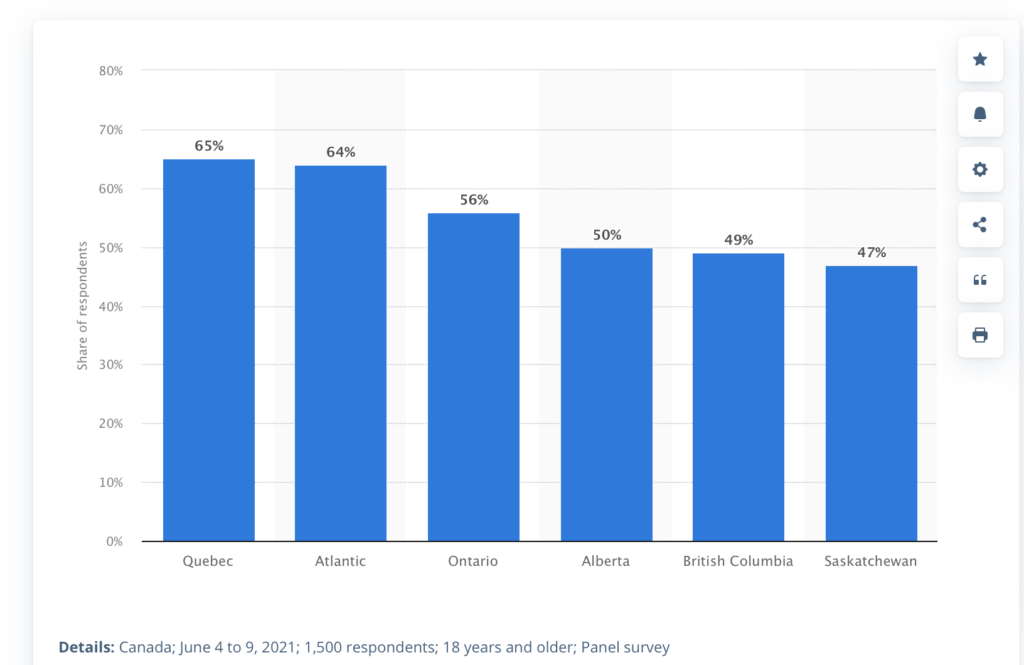
According to Statista, 32% of Canadians report owning a dog as a pet. There are almost no demographic differences in the type of pet people own. Those under 44 are as likely to own a cat or dog as those 45 and over. Women are slightly more likely to own a pet than men (59% vs. 54%). Pet ownership is higher in Quebec, Atlantic Canada, and Ontario and less likely in the Prairies and in BC and Saskatchewan. Quebec were the most likely to have a pet. Pet ownership was lowest in Saskatchewan and Manitoba, where 47 percent of respondents stated that they had a pet.
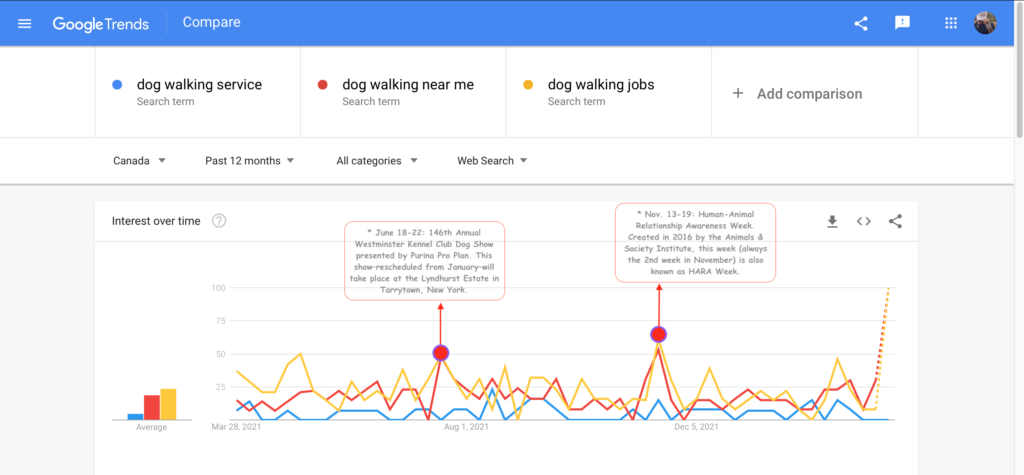
The two phrases “dog walking services” and “dog walking jobs” were searched more on 15 Nov and 18 June compared to other days of the year; therefore, we suggest offering a promotion code to enhance user experience in these days.
Insight from Statista and Google
Based on this data we can assume that our end-user can potentially be in an age range between 18 to 44 and more female. Also most of them are living in Quebec, Atlantic and Ontario respectively. British Columbia, Saskatchewan and Manitoba are the state with less pet owner.
To understand our end user better than always, Based on this data we also calculated the number of people with disability who own a pet in Canada.
If we assume that people with disabilities are as likely as other people (with or without disability) to have pets. And consider the fact that The number of people who own pets in Canada is 0.32 ( pet owner in Canada ) * 38 million (total population). Also the percentage of people with a disability in Canada is 0.16 * 38 million; therefore, the number of people with disability that have a pet at the same time could be 0.16 * 0.32 * 38 million = 1945600. based on this formula we found the importance of design for the people with disability
Based on the aforementioned data our target audience are the people with these characteristic
Pet Parent
1- People aged between 18 to 44 and 44 to +90
2- Working pet parents with busy work life
4- Most of them are in Quebec
Pet Lover
1- People aged between 18 to 44 and 45 to +90
2- Student who at least spend 1 year in this job
3- Most of them are in Quebec,
Survey for Data driven empathy map.
Statistical analysis method
The main objective here is to find factors (unobserved variables/ latent variables) i.e. visible variables in the data set that can create a factor that can be well interpreted and labeled, and finally create a model by factor analysis.
Factor analysis aims to reduce visible variables and convert them to hidden variables. This can be done in two steps.
Factor extraction: In this step, the number of factors and the factor extraction method are done by variance separation. This may be done by principal component analysis or factor analysis with common variance.
Rotation of factors: In the second step, in order to create independence (orthogonalization) between factors, we rotate them. The main goal of doing this is to interpret better the factors created. There are several ways to orthogonalize agents. Examples include the Varimax, Quartimax, or Promax rotation methods.
- loading data
After finding dog walking app audience characteristics In order to recruit survey participants, we notices about the survey with QR codes were displayed on bulletin boards in veterinary clinics, dog cafes, and dog shops. Potential participants were informed that participation in the study was entirely voluntary and that scanning a QR code would direct them to an online questionnaire created using the Google Form tool. In addition, participants were informed about the study objectives and confidentiality issues.
2. Questionnaire Design
some innovative questions are inserted by asking experts in the field of dogs-related affairs. There are 25 questions (observed Variable) which are answered randomly by 2800 dog owners/lovers and for each question, five different levels in the Likert scale are selected.
Cronbach’s alpha as a measure of reliability can be considered as a correlation coefficient between two questions that are used to measure the achievement of a goal. This index is a function of the number of items in the questionnaire, the average covariance between pairs of items and the variance of the questionnaire scores. As Cronbach’s alpha is about 0.52, Internal compatibility of items is considered weak even though for variables of Responsibility, it reaches about 0.81.
3. Adequacy Test
Before perform factor analysis, we need to evaluate the “factorability” of our dataset. Factorability means “can we find the factors in the dataset?”. There are two methods to check the factorability or sampling adequacy:
- Bartlett’s Test
- Kaiser-Meyer-Olkin Test
As a result, in this Bartlett ’s test, the p-value is 0. The test was statistically significant, indicating that the observed correlation matrix is not an identity matrix. And the overall KMO for our data is 0.84, which is excellent. This value indicates that we can proceed with your planned factor analysis.
4. Choosing the Number of Factors
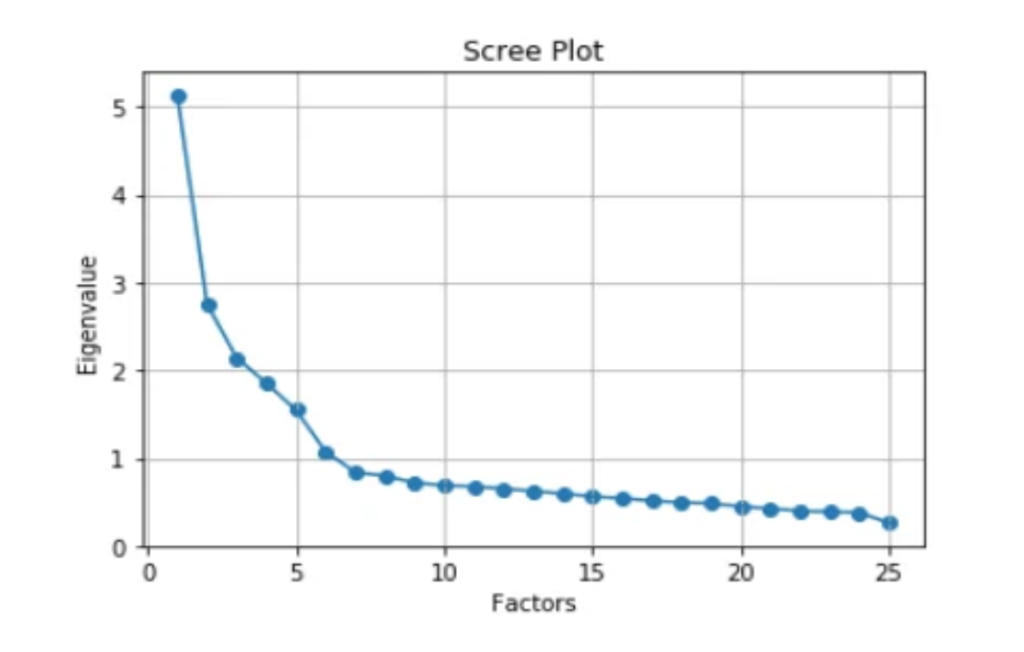
For choosing the number of factors, we can use the Kaiser criterion and scree plot. Both are based on eigenvalues.
5.Association of Dog Walking and Factors
The magnitude of the factor or loading means the absolute value of the desired value. For this reason, for example, for variable A1, the 5th factor was considered because the factor loading is so much greater than the absolute value of the loads of the other factor.
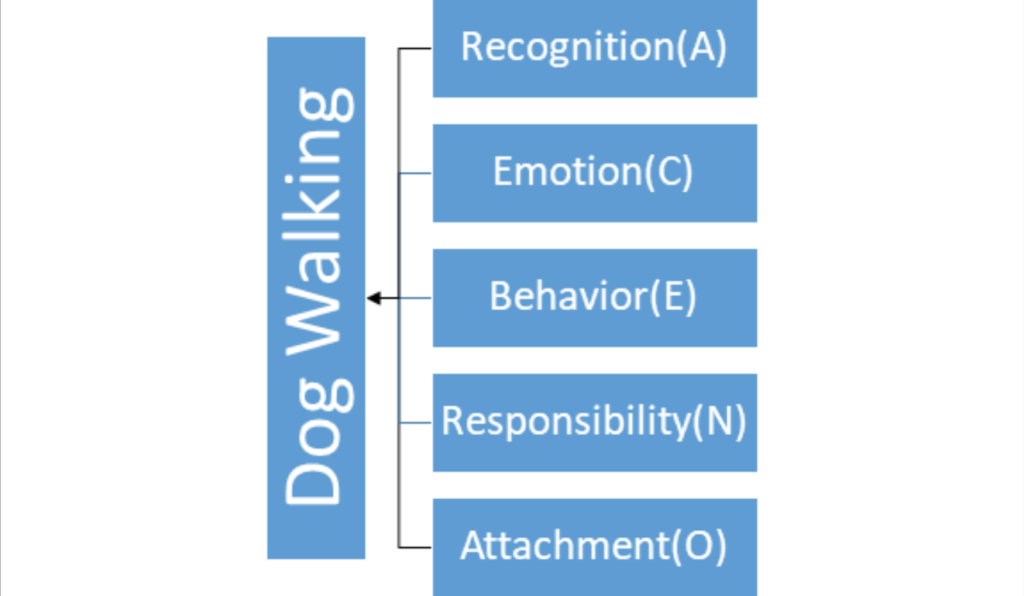
- Factor 1 has high factor loadings for E1,E2,E3,E4, and E5 (Behavior)
- Factor 2 has high factor loadings for N1,N2,N3,N4, and N5 (Responsibility)
- Factor 3 has high factor loadings for C1,C2,C3,C4, and C5 (Emotion)
- Factor 4 has high factor loadings for O1,O2,O3,O4, and O5 (Attachment)
- Factor 5 has high factor loadings for A1,A2,A3,A4, and A5 (Recognition)
- Factor 6 has none of the high loadings for any variable and is not easily interpretable. It’s good if we take only five factors
| A | C | E | N | O | |
| SS Loadings | 2.473090 | 2.709633 | 2.041106 | 1.522153 | 1.844498 |
| Proportion Var | 0.098924 | 0.108385 | 0.081644 | 0.060886 | 0.073780 |
| Cumulative Var | 0.098924 | 0.207309 | 0.288953 | 0.349839 | 0.423619 |
6-Dog Walking Questionnaire
Click here to see data driven categorized empathy map
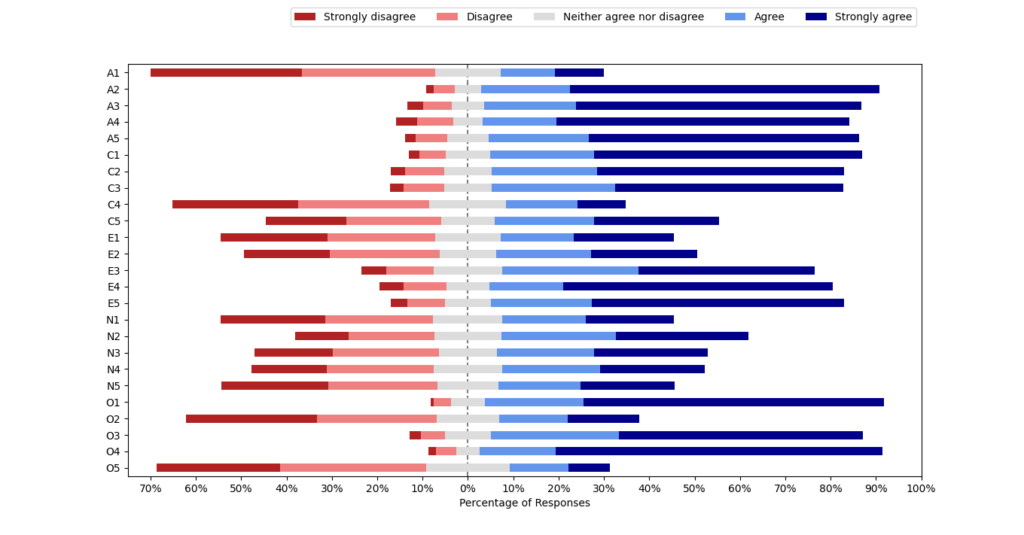
User journey map
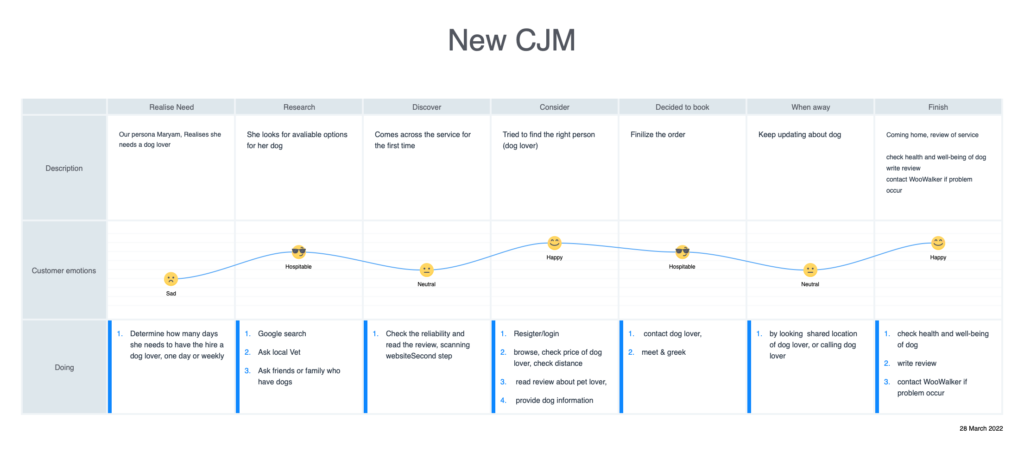
User flow
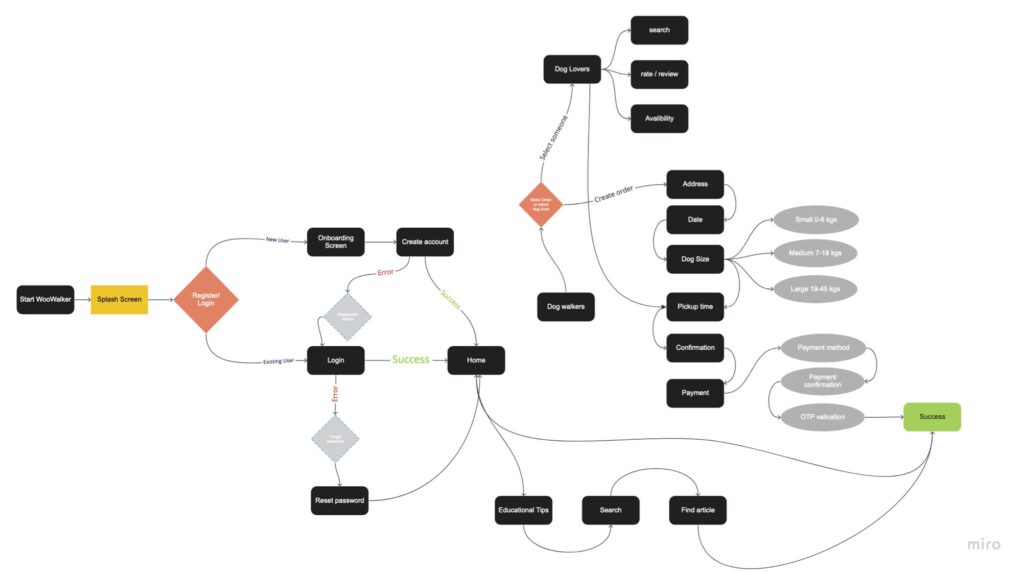
Wireframe
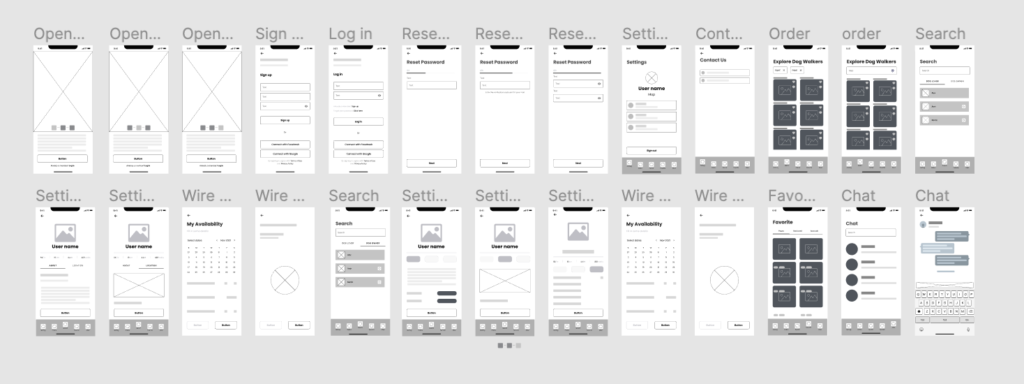
Design System
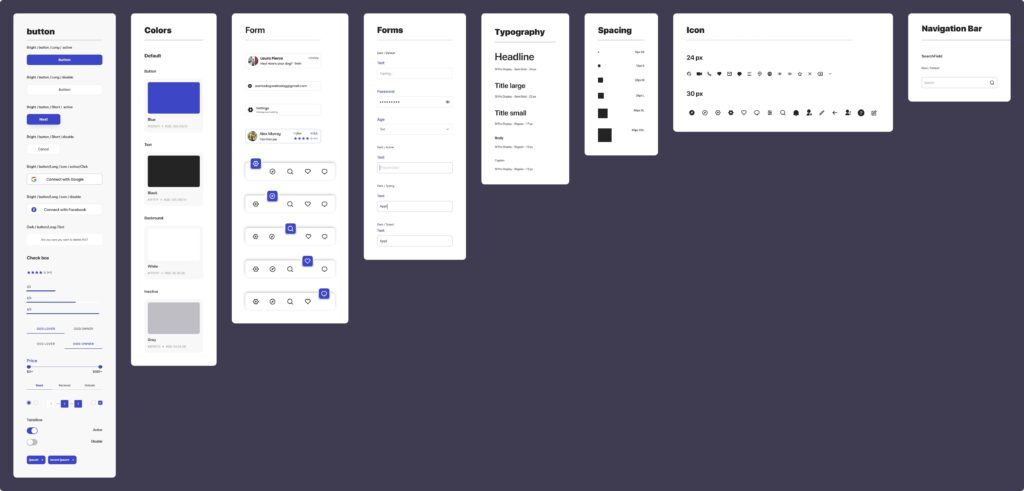
Checking color for people with disability
first our tool A11y shows us, we have issue in font size and contrast so we correct the design system based on the insight that tools gives us.
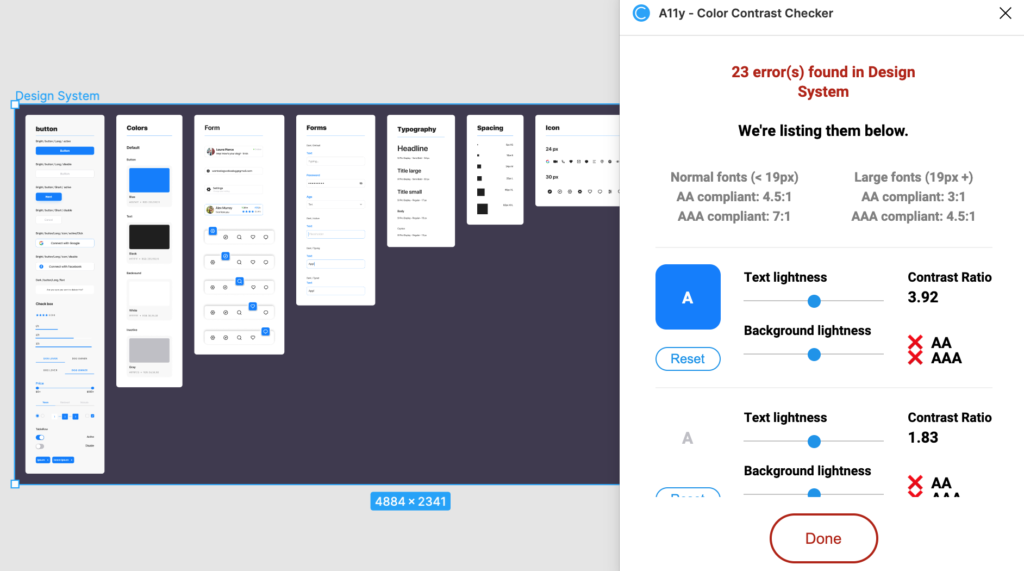
we have found issue in font size and color contrast in our design system
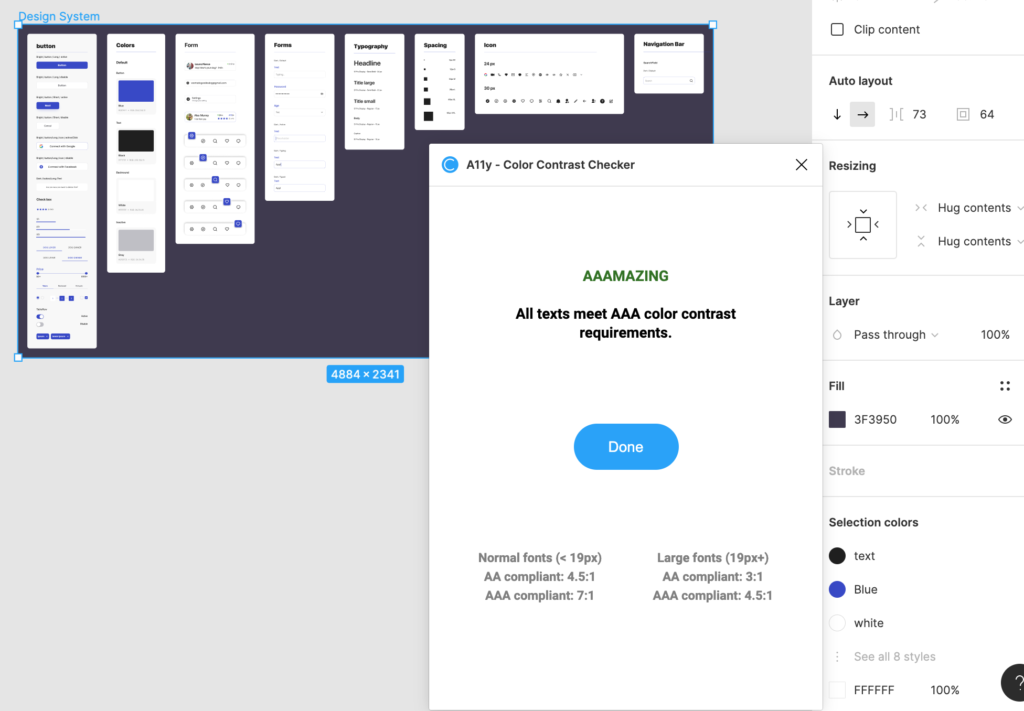
Our estimation demonstrated we have 2 million user with disability so It was important to us because we
Clickable prototype

WooWalker Usability Test Script
Our product now needed insights from real people to make sure we were on the right path. To gather insight, we conducted usability tests. The usability test gathers insights from users’ feedback towards the design prototype.
The testing also aimed to understand participants’ behaviors for the designed mockup. We used usertesting.com, a quick solution to finding participants for the test. We created a screener to test our target audience who inherited the qualities of Dogwalking apps users.
1. Test goals
2. Pre-test questions
3. Task list
4. Post-test questions / questionnaire
The goal of this user test is to answer the following questions:
– Does WooWalker meet the required features to function seamlessly as an application that can match dog lovers to dog owners?
– Can users open WooWalker and right away know more or less its purpose?
– What other problems can we uncover when users try to use WooWalker?
Usability Report
Results of usertesting.com (10 participants)
Participant profiles:
Quantitative
– 100% of participants could find a dog lover and dog owner.
– 70% of participants view filter option while 30% don’t view it at all
– 80 % participants are comfortable with switching between pet owner and pet lover tabs
Qualitative
– participants mention how they value security and keeping costs low by finding a good pet lover
– All participant are pet owner
– They’re sometime afraid to send wrong message to pet lover
First time moderate usability test
- What type of personas did we select for user research?
We bring 10 participants whose goals and characteristics (interests, concerns) represent the needs of a larger group of WooWalker users. We told them to act as they would on their own, including searching for pet lovers/owners, doing or abounding ordering. When experiencing troubles, the test subjects were asked open-ended questions such as:
- What are you thinking right now?,
- Why did you click there?,
- What did you expect would happen?
- why you choose this pet lovers?
- what would like to know before sending order to pet lover/owner
If the test subjects got stuck entirely, they were not helped at first. If they were still unable to move forward, they were offered support to get past a specific problem were given another task. On such events, it was reported in the research log and counted as a “failed task.” A study was also recorded as failed if participants completely misinterpreted a feature in the search page; at the end of the test we use this survey to understand our users better :
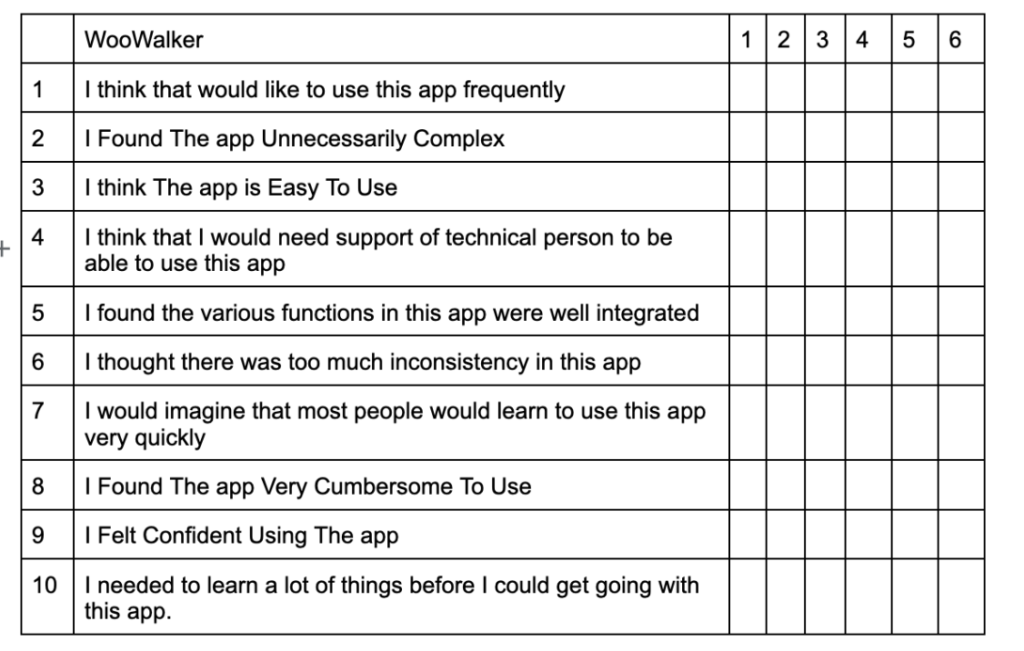
- Completely Agree
- Mostly Agree
- Slightly Agree
- Slightly Disagree
- Mostly Disagree
- Completely Disagree
- Result of Usability test
After 10 rounds of qualitative usability testing, following the “Think Aloud” protocol, in-person 1:1 moderated usability testing, and we found that:
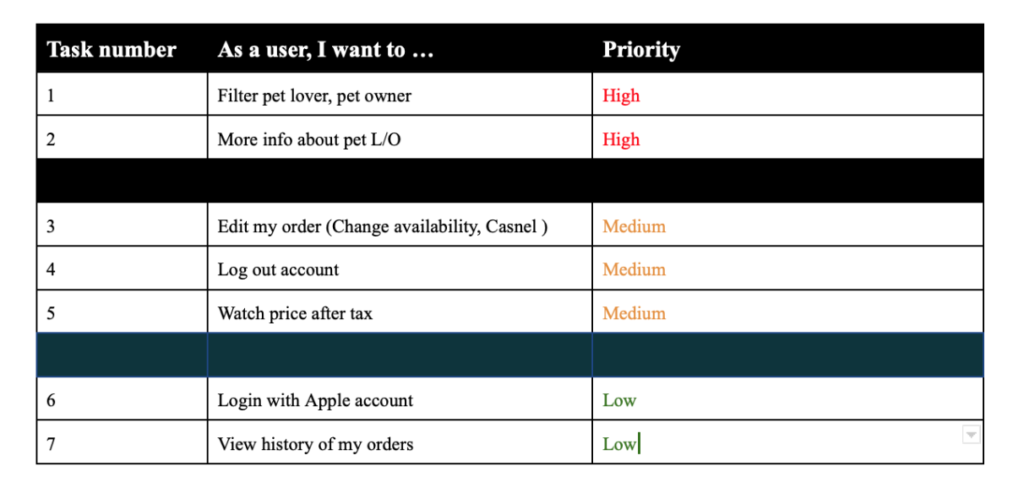
- We found that we forgot to bring the filter option to our application, participant wan not able to filter the results based on their preference.
- 70% of participants wants to see more information about pet lovers before opening cards. (reviews)
- 50% participants wan not able to find log out account (change location recommended)
- 70% of participants wants to see the final price (no hidden fees)
Filter section !
We used Analytic Hierarchy Process to find weight of our criterion into the filter section of the WooWalker application. AHP is a method to organize and analyze complex decisions using math and psychology. We would like to know the weight of the Gender criterion, price, availability, and age for our end-user (which one is more important in comparison the another one). AHP algorithm compares criterions to help us find a universal pattern that works for almost all people by measuring Consistency Ration. Here we found that Price priority is 51.4%, availability is 25.3%, pet size is 16.8, age is 4.6%, and gender with 3.9.
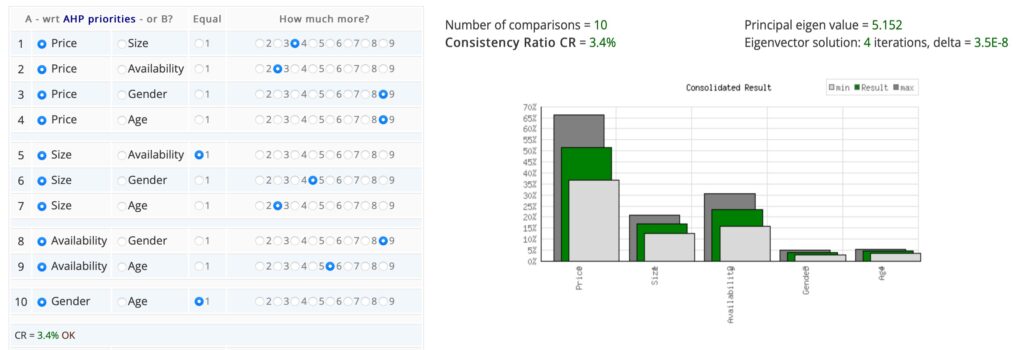
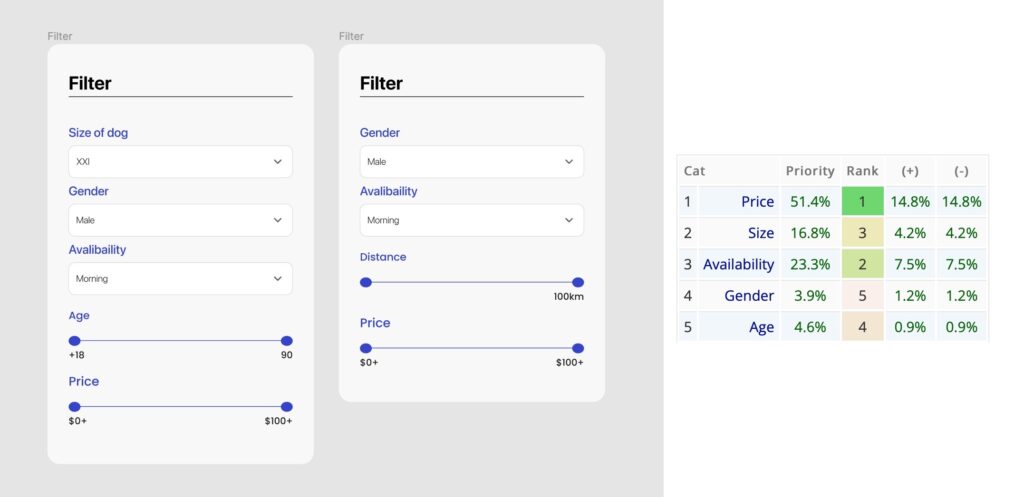
Next Usability
- 100% of users was able to filter easily the results of search.
- They can find more information from pet lowers/owners before opening card
- 90% participants was successful to send an order to each other
- 90% participants find log out under setting pages easily
- 80% participants found the history of their orders
Click here interview transcript
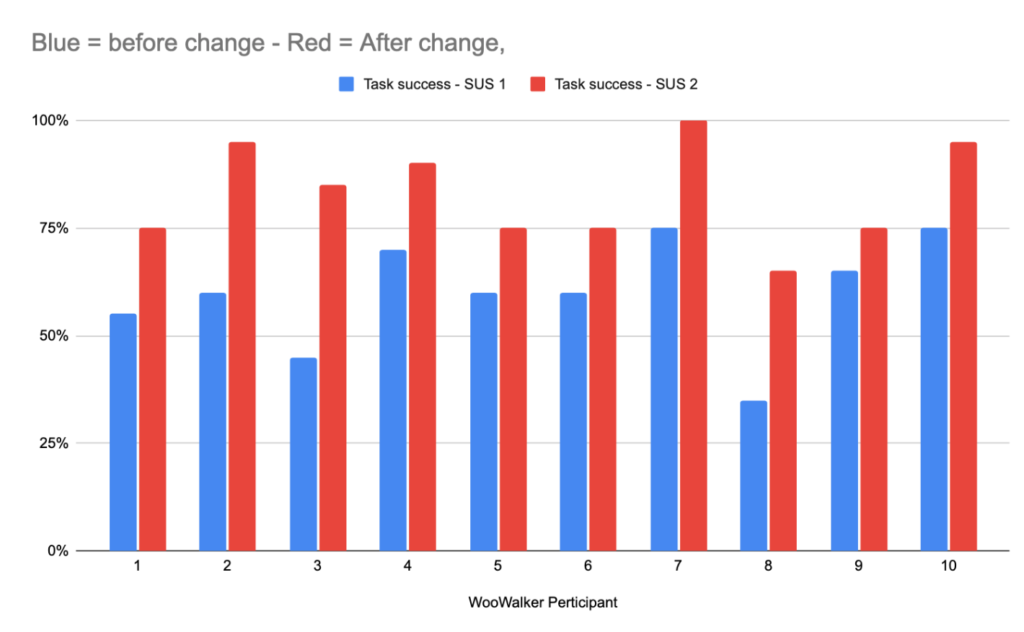
Packaging the assets
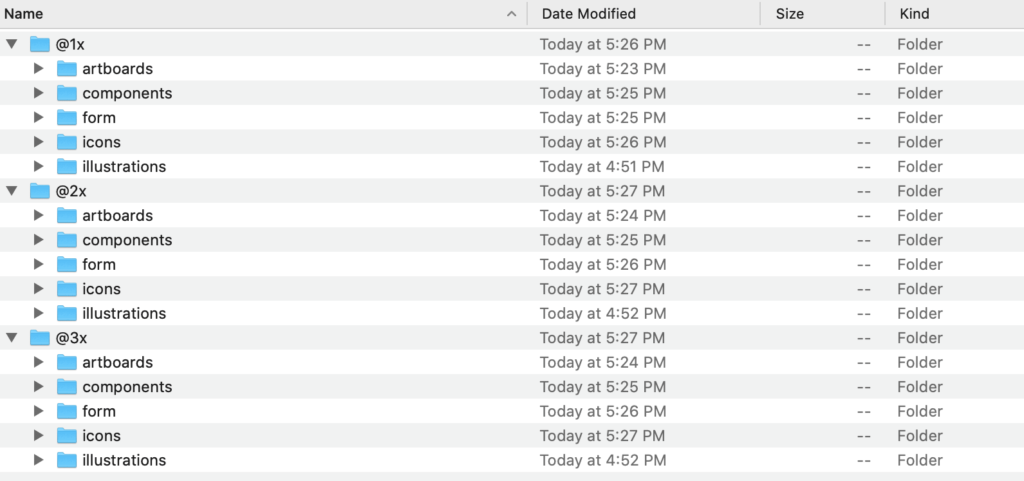
To cap it off, we conducted one last round of basic usability testing to see what could be improved in further iterations down the road.
The last stage was to organize the assets in a way suitable for easy hand off to developers. The folder assembled for hand off includes static assets as well as the Sketch file. For reference, a link to the WooWalker prototype can be found as well so developers can view micro-interactions.
Assets are organized by @1x, @2x and @3x for neat file structure. Beyond the export scaling, folders for the art boards, components, form elements, icons and illustrations can be found – all in lowercase letters.
